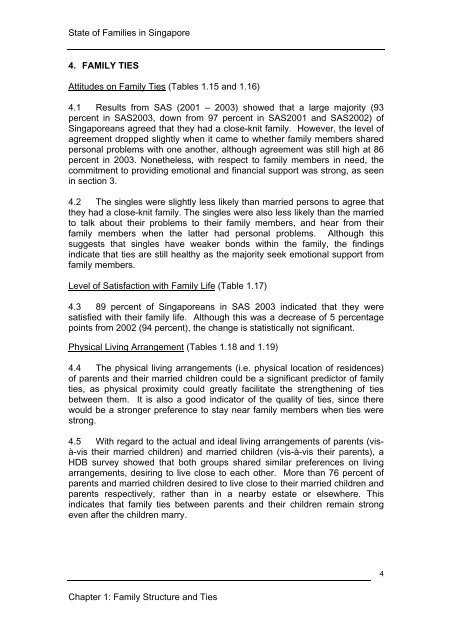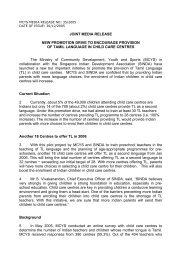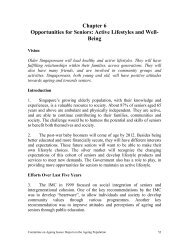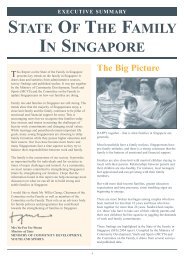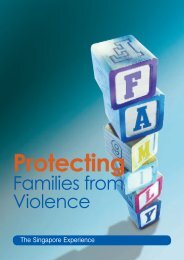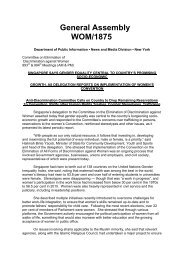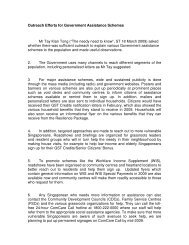STATE OF THE FAMILY IN SINGAPORE, 2003 - Ministry of Social ...
STATE OF THE FAMILY IN SINGAPORE, 2003 - Ministry of Social ...
STATE OF THE FAMILY IN SINGAPORE, 2003 - Ministry of Social ...
Create successful ePaper yourself
Turn your PDF publications into a flip-book with our unique Google optimized e-Paper software.
State <strong>of</strong> Families in Singapore4. <strong>FAMILY</strong> TIESAttitudes on Family Ties (Tables 1.15 and 1.16)4.1 Results from SAS (2001 – <strong>2003</strong>) showed that a large majority (93percent in SAS<strong>2003</strong>, down from 97 percent in SAS2001 and SAS2002) <strong>of</strong>Singaporeans agreed that they had a close-knit family. However, the level <strong>of</strong>agreement dropped slightly when it came to whether family members sharedpersonal problems with one another, although agreement was still high at 86percent in <strong>2003</strong>. Nonetheless, with respect to family members in need, thecommitment to providing emotional and financial support was strong, as seenin section 3.4.2 The singles were slightly less likely than married persons to agree thatthey had a close-knit family. The singles were also less likely than the marriedto talk about their problems to their family members, and hear from theirfamily members when the latter had personal problems. Although thissuggests that singles have weaker bonds within the family, the findingsindicate that ties are still healthy as the majority seek emotional support fromfamily members.Level <strong>of</strong> Satisfaction with Family Life (Table 1.17)4.3 89 percent <strong>of</strong> Singaporeans in SAS <strong>2003</strong> indicated that they weresatisfied with their family life. Although this was a decrease <strong>of</strong> 5 percentagepoints from 2002 (94 percent), the change is statistically not significant.Physical Living Arrangement (Tables 1.18 and 1.19)4.4 The physical living arrangements (i.e. physical location <strong>of</strong> residences)<strong>of</strong> parents and their married children could be a significant predictor <strong>of</strong> familyties, as physical proximity could greatly facilitate the strengthening <strong>of</strong> tiesbetween them. It is also a good indicator <strong>of</strong> the quality <strong>of</strong> ties, since therewould be a stronger preference to stay near family members when ties werestrong.4.5 With regard to the actual and ideal living arrangements <strong>of</strong> parents (visà-vistheir married children) and married children (vis-à-vis their parents), aHDB survey showed that both groups shared similar preferences on livingarrangements, desiring to live close to each other. More than 76 percent <strong>of</strong>parents and married children desired to live close to their married children andparents respectively, rather than in a nearby estate or elsewhere. Thisindicates that family ties between parents and their children remain strongeven after the children marry.4Chapter 1: Family Structure and Ties


